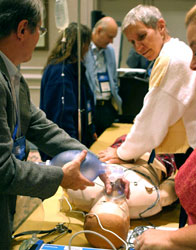Simulation: Up Close and Personal - SimLEARN
<< back to Simulation National Leadership Conference 2010 Home page
Tues. 9/14/2010 - PM
 Tuesday afternoon gave participants at the conference a chance to see and experience simulation first-hand. In smaller groups, they moved through a series of small labs and demonstration areas to learn about some of the different simulation modalities available. This quick succession of overviews included virtual patients, standardized patients, task trainers and mannequin-based simulation. Equipment ranged from low fidelity body parts to high fidelity integrated physiology equipment.
Tuesday afternoon gave participants at the conference a chance to see and experience simulation first-hand. In smaller groups, they moved through a series of small labs and demonstration areas to learn about some of the different simulation modalities available. This quick succession of overviews included virtual patients, standardized patients, task trainers and mannequin-based simulation. Equipment ranged from low fidelity body parts to high fidelity integrated physiology equipment.
For example, Patricia Burnell exhibited an inexpensive inflatable torso that healthcare personnel use to stay practiced in CPR skills. Dr. Elizabeth Hunt and Dr. Kristen Nelson-McMillen took participants on a tour of a fully integrated mannequin with respiratory and cardio-pulmonary systems, dilating pupils, and vocalization capabilities. Then with volunteers from that group, the high-fidelity mannequin was run through a critical emergency room simulation.
Dr. Anil Krishnamurthy demonstrated laparoscopic surgical techniques using an integration of 3D computer imagery and haptic, simulated tools. He pointed out that the strength of such integrated simulation is its use to teach basic skills as well as to aid diagnostic training. And more contextual cues can be programmed into the computer-like verbal patient response to a painful error-to make the procedures more realistic. Dr. Rosalyn Scott pointed out the additional advantages of having augmented reality functions available on the computer monitor, like an anatomical map superimposed on an x-ray, to boost the instructional effectiveness for the learner.
Other presenters included Drs. Salma Akram, Dmitriy Babichanko, Pamela Baugham, Bruce Binder, Jerome Borchers, Briar Duffy, Larry Goldenberg, Kyle Harrison, Jonathan Heart, Teppituk Krinchai, Geoff Lighthall, Alberto Lopez, Jo-Anne Suffoletto, and Jessica Zagory.



















